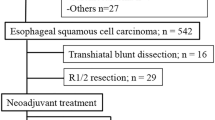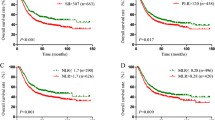Abstract
Background
Immunoinflammatory measures such as the neutrophil–lymphocyte ratio (NLR), the platelet–lymphocyte ratio (PLR), and the C-reactive protein (CRP)–albumin ratio (CAR) are useful prognostic measures in various malignancies. However, no study has investigated the correlation of these measures with microenvironmental inflammation. Periostin (POSTN), a small extracellular matrix protein, strongly associates with cancer microenvironmental inflammation. The current study investigated the correlation of NLR, PLR, and CAR with periostin expression in esophageal squamous cell carcinoma (ESCC).
Methods
The study retrospectively evaluated preoperative NLR, PLR, and CAR hematologically and POSTN immunohistochemically in 171 patients. The correlation of immunoinflammatory measures, POSTN expression, and survival outcomes was measured.
Results
The study showed a significant correlation of POSTN-positive expression with poor overall survival (OS) (P < 0.0001) and recurrence-free survival (RFS) (P = 0.03). The POSTN-positive group had higher PLR (189.6 ± 8 vs. 159.3 ± 12; P = 0.04) and CAR (0.36 ± 0.06 vs. 0.14 ± 0.09; P < 0.05) than the POSTN-negative group, whereas NLR did not differ between the two groups (3.27 ± 0.19 vs. 2.65 ± 0.28; P = 0.07). The uni- and multivariate analyses showed that POSTN-positive expression (hazard ratio [HR], 1.595; 95% confidence interval [CI], 0.770–3.031; P = 0.03), CAR (HR, 1.663; 95% CI, 1.016–2.764; P = 0.03), gender (HR, 2.303; 95% CI, 1.067–6.019; P = 0.03), and tumor depth (HR, 1.957; 95% CI, 1.122–3.526; P = 0.01) were independent prognostic factors.
Conclusions
Because POSTN-positive expression strongly correlates with immunoinflammatory measures, especially PLR and CAR, it is an independent prognostic factor in ESCC.





Similar content being viewed by others
References
Bray F, Ferlay J, Soerjomataram I, Siegel RL, Torre LA, Jemal A. Global cancer statistics 2018: GLOBOCAN estimates of incidence and mortality worldwide for 36 cancers in 185 countries. CA Cancer J Clin. 2018;68:394–424.
Gupta B, Kumar N. Worldwide incidence, mortality and time trends for cancer of the oesophagus. Eur J Cancer Prevent. 2017;26:107–118.
Walsh S, Cook E, Goulder F, Justin T, Keeling N. Neutrophil–lymphocyte ratio as a prognostic factor in colorectal cancer. J Surg Oncol. 2005;91:181–4.
Ishibashi Y, Tsujimoto H, Hiraki S, et al. Prognostic value of preoperative systemic immunoinflammatory measures in patients with esophageal cancer. Ann Surg Oncol. 2018;25:3288–99.
Kudo A. Introductory review: periostin–gene and protein structure. Cell Mol life Sci. 2017;74:4259–68.
Ohno F, Nakahara T, Kido-Nakahara M, et al. Periostin links skin inflammation to melanoma progression in humans and mice. Int J Mol Sci. 2019;20:169.
Deng X, Ao S, Hou J, Li Z, Lei Y, Lyu G. Prognostic significance of periostin in colorectal cancer. Chin J Cancer Res. 2019;31:547.
Brierley JD, Gospodarowicz MK, Wittekind C TNM Classification of Malignant Tumours. Oxford: Wiley; 2017
Ando N, Kato H, Igaki H, et al. A randomized trial comparing postoperative adjuvant chemotherapy with cisplatin and 5-fluorouracil versus preoperative chemotherapy for localized advanced squamous cell carcinoma of the thoracic esophagus (JCOG9907). Ann Surg Oncol. 2012;19:68–74.
Schisterman EF, Perkins NJ, Liu A, Bondell H. Optimal cut-point and its corresponding Youden Index to discriminate individuals using pooled blood samples. Epidemiology. 2005;16:73–81.
Shinto E, Tsuda H, Ueno H, et al. Prognostic implication of laminin-5 gamma 2 chain expression in the invasive front of colorectal cancers, disclosed by area-specific four-point tissue microarrays. Lab Invest. 2005;85:257.
Ishibashi Y, Tsujimoto H, Yaguchi Y, Kishi Y, Ueno H. Prognostic significance of systemic inflammatory markers in esophageal cancer: systematic review and meta-analysis. Ann Gastroenterol Surg. 2019;4:56–63.
Chen M-F, Chen P-T, Kuan F-C, Chen W-C. The predictive value of pretreatment neutrophil-to-lymphocyte ratio in esophageal squamous cell carcinoma. Ann Surg Oncol. 2019;26:190–9.
Horiuchi K, Amizuka N, Takeshita S, et al. Identification and characterization of a novel protein, periostin, with restricted expression to periosteum and periodontal ligament and increased expression by transforming growth factor β. J Bone Miner Res. 1999;14:1239–49.
Underwood TJ, Hayden AL, Derouet M, et al. Cancer-associated fibroblasts predict poor outcome and promote periostin-dependent invasion in oesophageal adenocarcinoma. J Pathol. 2015;235:466–77.
Ma H, Wang J, Zhao X, et al. Periostin promotes colorectal tumorigenesis through integrin-FAK-Src pathway-mediated YAP/TAZ activation. Cell Rep. 2020;30:793–806.e796.
Moniuszko T, Wincewicz A, Koda M, Domysławska I, Sulkowski S. Role of periostin in esophageal, gastric, and colon cancer. Oncol Lett. 2016;12:783–7.
Koh S-J, Choi Y, Kim BG, et al. Matricellular protein periostin mediates intestinal inflammation through the activation of nuclear factor κB signaling. PloS One. 2016;11:e0149652
Coussens LM, Werb Z. Inflammation and cancer. Nature. 2002;420:860–7.
Wang W, Sun Q-K, He Y-F, et al. Overexpression of periostin is significantly correlated to the tumor angiogenesis and poor prognosis in patients with esophageal squamous cell carcinoma. Int J Clin Exp Pathol. 2014;7:593.
Jia W, Wang W, Ji C-S, et al. Coexpression of periostin and EGFR in patients with esophageal squamous cell carcinoma and their prognostic significance. Onco Targets Ther. 2016;9:5133.
Huang C, Yang G, Jiang T, Huang K, Cao J, Qiu Z. Effects of IL-6 and AG490 on regulation of Stat3-signaling pathway and invasion of human pancreatic cancer cells in vitro. J Exp Clin Cancer Res. 2010;29:51.
Tu B, Du L, Fan Q-M, Tang Z, Tang T-T. STAT3 activation by IL-6 from mesenchymal stem cells promotes the proliferation and metastasis of osteosarcoma. Cancer Lett. 2012;325:80–8.
Walter M, Liang S, Ghosh S, Hornsby PJ, Li R. Interleukin 6 secreted from adipose stromal cells promotes migration and invasion of breast cancer cells. Oncogene. 2009;28:2745–55.
Tsujimoto H, Ono S, Ichikura T, Matsumoto Y, Yamamoto J, Hase K. Roles of inflammatory cytokines in the progression of gastric cancer: friends or foes? Gastric Cancer. 2010;13:212–21.
Del Giudice M, Gangestad SW. Rethinking IL-6 and CRP: why they are more than inflammatory biomarkers, and why it matters. Brain Behav Immun. 2018;70:61–75.
Chen Z, Sun H, Yue B, Li JH. Expressions and clinical significance of periostin, VEGF, ET-1, and Hs-CRP in patients with acute coronary syndrome. Jiangsu Med J. 2013;39:929–31.
Dixon MR, Haukoos JS, Udani SM, et al. Carcinoembryonic antigen and albumin predict survival in patients with advanced colon and rectal cancer. Arch Surg. 2003;138:962–6.
Kaysen GA, Chertow GM, Adhikarla R, Young B, Ronco C, Levin NW. Inflammation and dietary protein intake exert competing effects on serum albumin and creatinine in hemodialysis patients. Kidney Int. 2001;60:333–40.
Bologa RM, Levine DM, Parker TS, et al. Interleukin-6 predicts hypoalbuminemia, hypocholesterolemia, and mortality in hemodialysis patients. Am J Kidney Dis. 1998;32:107–14.
Funding
None.
Author information
Authors and Affiliations
Corresponding author
Ethics declarations
Disclosure
There are no conflicts of interest.
Informed Consent
Written informed consent was obtained from all patients
Additional information
Publisher's Note
Springer Nature remains neutral with regard to jurisdictional claims in published maps and institutional affiliations.
Rights and permissions
About this article
Cite this article
Ishibashi, Y., Tsujimoto, H., Einama, T. et al. Correlation Between Immunoinflammatory Measures and Periostin Expression in Esophageal Squamous Cell Carcinoma: A Single-Center, Retrospective Cohort Study. Ann Surg Oncol 28, 1228–1237 (2021). https://doi.org/10.1245/s10434-020-08765-3
Received:
Published:
Issue Date:
DOI: https://doi.org/10.1245/s10434-020-08765-3




